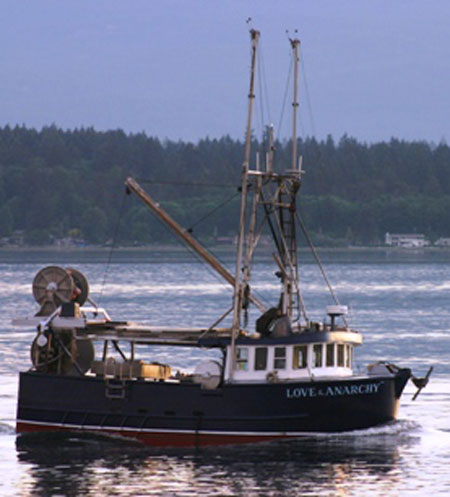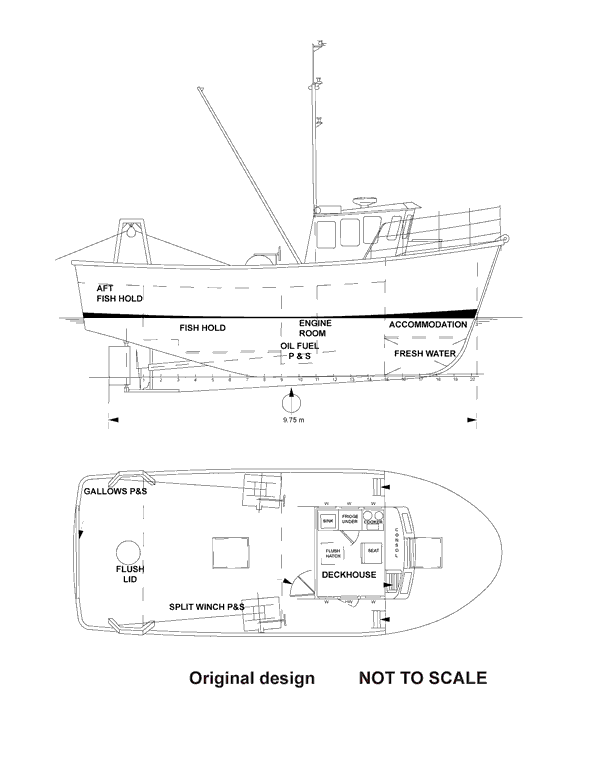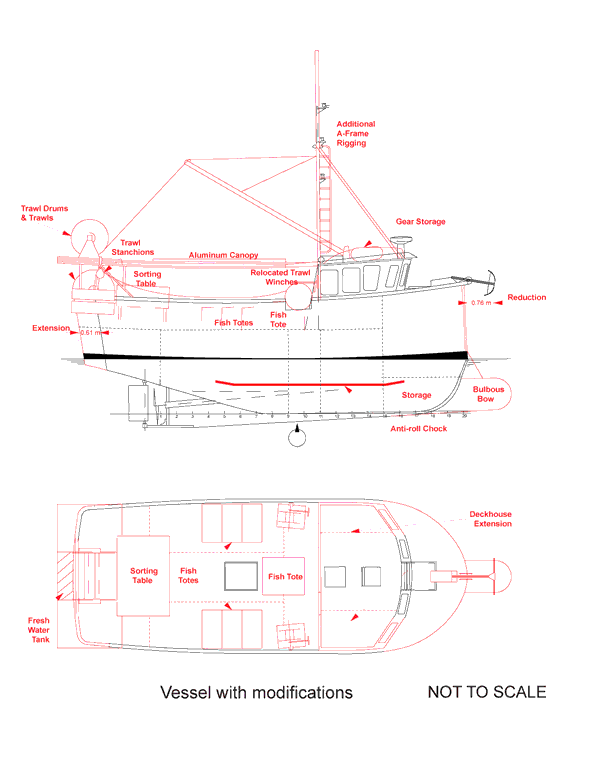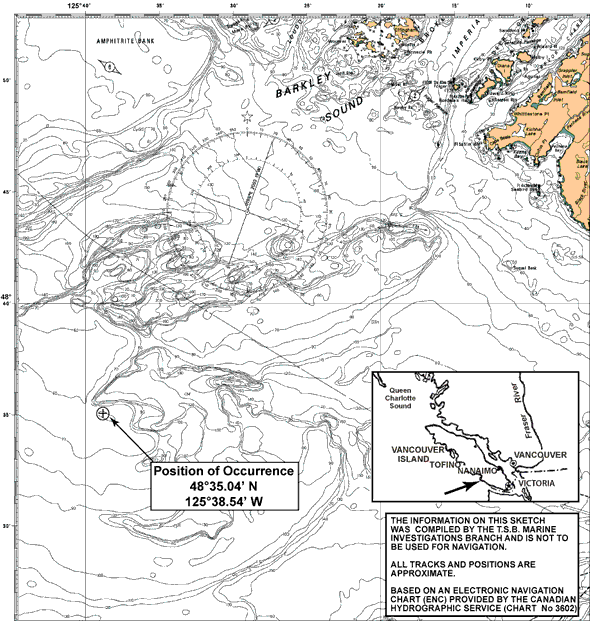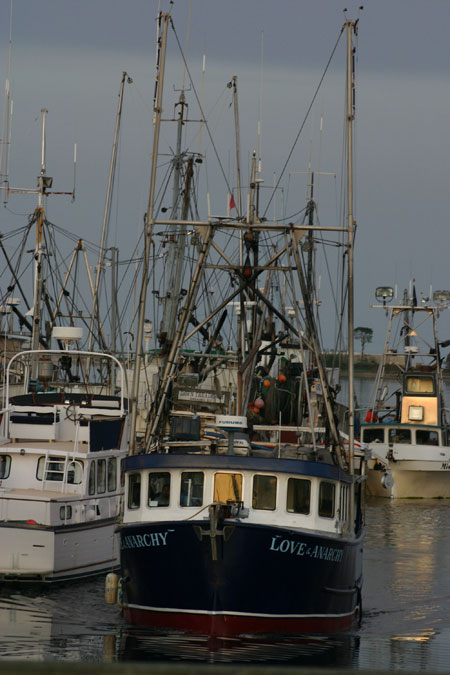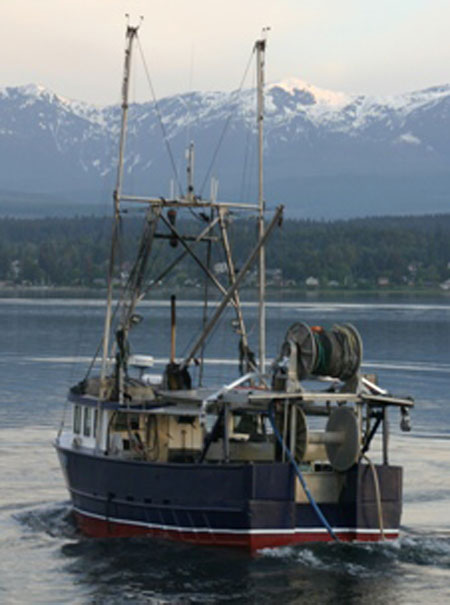Capsizing and subsequent sinking
Small fishing vessel Love and Anarchy
West Coast of Vancouver Island, British Columbia
The Transportation Safety Board of Canada (TSB) investigated this occurrence for the purpose of advancing transportation safety. It is not the function of the Board to assign fault or determine civil or criminal liability. This report is not created for use in the context of legal, disciplinary or other proceedings. See Ownership and use of content. Masculine pronouns and position titles may be used to signify all genders to comply with the Canadian Transportation Accident Investigation and Safety Board Act (S.C. 1989, c. 3).
Summary
On the early morning of 04 September 2008, the small fishing vessel Love and Anarchy capsized and sank while anchored on Swiftsure Bank, 20 nautical miles southwest of Cape Beale, British Columbia. The owner and the crew member were rescued by another fishing vessel.
Factual information
Particulars of the vessel
| Name of vessel | Love and Anarchy |
|---|---|
| Registry number | 814390 |
| Licence number | VRN 29496 |
| Port of registry | Vancouver, (B.C.) |
| Flag | Canada |
| Type | Small fishing vessel-troll and trawl |
| Gross tonnage | 14.57 |
| LengthFootnote 1 | 10.82 m |
| Draught | 1.7 m |
| Built | 1990, Vancouver, B.C. |
| Propulsion |
V6-71 Detroit Diesel engine, 149 kW, single fixed pitch propeller |
| Cargo |
Approximately 800 kg of salmon and 3 tonnes of ice |
| Crew | 2 |
| Registered owner | Private owner, Comox, B.C. |
Description of the vessel
The Love and Anarchy was built as a small fishing vessel of closed construction with a welded steel hull. The aluminum deckhouse, the crew accommodation, and engine room space were located forward of amidships. Below the main working deck, three transverse watertight bulkheads subdivided the hull into crew accommodation, engine room, four insulated fish holds, and the lazarette (see Appendix A-1).
The lazarette and the fish holds—three longitudinal and one transverse—were located aft. Each fish hold was fitted with a watertight flush-fitting manhole and a non-watertight aluminum hatch cover on a 5-cm raised coaming. Portable deck boards covering the manholes were used to make the working deck flush with the hatch covers.
The vessel had two fuel tanks—one on either side of the main engine. The fresh water tank was located in the stern. Two general service pumps in the engine room used common valves and piping for pumping the bilge, lazarette, and fish holds.
The main working deck was aft, surrounded by solid bulwark, and contained trawl gear, a sorting table, salmon-trolling gear, a full-sized fish tote, and six half-sized fish totes.Footnote 2 In addition, a second trawl drum was fitted above the original at the stern.
The deckhouse was equipped with navigation and communications equipment including radar, a depth sounder, three very high frequency (VHF) radiosFootnote 3, an autopilot, and a global positioning system (GPS).
Vessel rigging consisted of an aluminum A-frame mast, a steel lifting boom, and trolling poles.
The vessel carried a 2.3 m skiff, a four-person liferaft, a portable gasoline water pump, and fish hold penboards, all stowed atop the deckhouse.
The vessel had a permanent port list (see Appendix C, Photo 3), which had been apparent since at least 1995.
History of the voyage
On the morning of 31 August 2008 in Ucluelet, B.C., water and fuel tanks were topped up and the vessel was loaded with three tonnes of ice. One-half tonne was used to fill four fish totes on deck; the remainder was stowed in the aft fish hold without penboards.Footnote 4 To eliminate the port list, the owner had pumped seawater into the starboard fish hold and consumed fuel from the port tank. Normal practice was to remove this water later as fuel was being consumed.
The vessel then left for a sport-fishing trip with the owner and two friends aboard. Later that day, the vessel tied up in Bamfield, B.C.
On 01 September 2008, the vessel departed Bamfield. By this time—and despite the fact that the owner had been consuming fuel from the port tank—a port list re-developed. In an attempt to eliminate this unexplained list, the owner used one of the general service pumps to remove melted ice from the aft fish hold. He then pumped more seawater to the starboard fish hold, eliminating the list. The pump made an unusual noise during the procedure but continued to operate.
Later that day, the vessel trawled for shrimp, stowing its 360 kg catch in totes on deck before eventually delivering it in Ucluelet. At that point the two friends left the vessel and a crew member joined to participate in the salmon troll fishery.
At 0400Footnote 5 on 02 September 2008, the vessel departed Ucluelet and travelled to the salmon fishing grounds. Although the half-sized fish totes could fit into the fish holds, they were kept on the working deck for ease of stowing catch and unloading. More totes containing fish were stowed on the starboard working deck to compensate for the increasing port list. That night, the vessel anchored on Swiftsure Bank.
On 03 September 2008, the unexplained port list continued to increase, despite the even distribution of approximately 800 kg catch (plus ice) in totes on deck. To compensate, seawater was pumped into the starboard fish hold, again temporarily eliminating the port list. The vessel was anchored on Swiftsure Bank for the night, in the vicinity of other fishing vessels, in position 48°35.04′ N, 125°38.54′ W (see Appendix B—Area of the occurrence).
During the night the vessel came to lie broadside to the waves. The vessel's rolling and noise from shifting equipment woke the owner at approximately 0330. At this time, the vessel was trimmed by the stern and again had a port list, and water was being shipped on deck in the area of the hatch covers. The owner started the engine and began pumping from the port fish hold. After a few minutes, the pump ceased discharging water but continued operating, with minimal change in the vessel's condition.
After several unsuccessful attempts with both pumps to pump out the fish holds, the owner woke up the crew member, who donned a lifejacket and went on deck. The owner returned to the engine room and continued to try to correct the vessel's condition.
The crew member, meanwhile, retrieved the immersion suits from the accommodation and placed them on deck along the aft bulkhead of the deckhouse.
After a large wave shipped water over the starboard bulwark and downflooded into fish holds, the crew member partially donned his immersion suit. The owner emerged from the engine room and both men entered the deckhouse to attempt a distress call. The call was not transmitted. As the trim by stern and port list increased, the distress call attempt was abandoned and the owner and crew member returned to the deck. The crew member removed his lifejacket and finished donning the immersion suit. As the vessel rolled to port, a full tote of fish shifted, pinning the owner's immersion suit to the deckhouse. The owner donned the lifejacket, and both men climbed onto the hull as the vessel rolled onto its beam ends.
After making his way forward along the starboard side of the hull, the owner freed the liferaft from atop the deckhouse, but it failed to inflate. Within minutes, the vessel capsized and the owner and crew member made their way onto the keel and toward the stern. With the vessel sinking by the bow, the crew member swam toward nearby fishing vessels. Once the vessel sank, the owner clung to debris that had floated free.
The crew member was picked up by the fishing vessel Pacific Reward, which then located and rescued the owner, who was treated for hypothermia. Both men were transferred to the Canadian Coast Guard Cutter Cape Endesaw and transported to Ucluelet.
Personnel certification and experience
The owner had over 25 years of experience on fishing vessels, the last 13 aboard the Love and Anarchy; most of these were spent trawling ground fish and shrimp, and trolling salmon. The owner held no certificate of competency, nor was one required by regulation. He had not taken the required marine emergency duties (MED) training.
The crew member had taken the required MED training. He had five years of experience on and around small fishing vessels and made several short trips per year as a crew member.
Vessel certification
As a small fishing vessel not exceeding 15 gross tonnage, the Love and Anarchy was subject to Part II of the current Small Fishing Vessel Inspection Regulations (SFVIR). As such, the vessel did not require any inspection by Transport Canada (TC), nor was there a requirement to submit stability data.
Weather and current information
The Environment Canada weather buoy at La Perouse Bank, 20 nautical miles (nm) west of the occurrence location, indicated an average wave height of 1.5 m and NW winds 13 knots, gusting to 19 knots over the morning of the occurrence.
Fisheries and Oceans Canada tide and current tables for Juan de Fuca-West, 10 nm east of the occurrence, indicated maximum ebb tide of 1.8 knots at 0020.
Marine personnel regulations
As of July 2007, the Marine Personnel Regulations require operators of fishing vessels 15 gross tonnage or less to hold a Small Vessel Operator Proficiency (SVOP) certificate. The syllabus for the SVOP training certificate contains one hour of instructionFootnote 6 on vessel stability. ProvisionsFootnote 7, however, allow fishing vessel operators who, prior to July 2007, have seven seasons of experience as mastersFootnote 8 to be exempt from this requirement.
Implementation of the Marine Personnel Regulations will take place over time, and operators of vessels similar in size (6 to 12 m) to the Love and Anarchy will require the SVOP certificate as of 07 November 2015.Footnote 9
Vessel modifications
Under the Canada Shipping Act, owners and masters have primary responsibility for the safety of their vessels. Specifically, for fishing vessels under 15 gross tonnage, they are required to report modifications made to their vessels to TC. Owners of fishing vessels under 15 gross tonnage are encouraged to maintain a record of modifications and to solicit the assistance of a marine consultant if these may result in a substantive change to the safety and stability of the vessel. TC Ship Safety Bulletin 01/2008 details this approach.
Modification history
The Love and Anarchy was built in 1990 and modelled after an existing plan for an 11.3 m trawler. Changes to the original design were made to meet Department of Fisheries and Oceans' (DFO) licence length restrictionsFootnote 10 by removing 0.76 m from the bow of the vessel.
Further changes to the original design included widening the deckhouse by 1.5 m, raising the boom location, and changing the rigging to an A-frame style.
In 1993, prior to DFO's fishing vessel re-measurement program, DFO approvedFootnote 11 the lengthening of the vessel with a 0.61 m extension to the stern, which included a fresh water tank. Furthermore, a bulbous bow and anti-roll chocks were fitted to the hull.
The vessel was sold in 1994 to the current owner, who made a number of changes, including:
- installing additional rigging to the A-frame
- adding a large aluminum sorting table to the deck
- fitting a second trawl drum above the original
- adding an aluminum canopy to cover the working deck
- relocating the trawl stanchion above original trawl drum
- relocating the trawl winches forward and higher
- removal of fresh water containers from bow
These modifications outfitted the vessel with equipment needed to participate in the following fisheries: salmon trolling, shrimp trawlingFootnote 12, and bottom trawling. It was common for the vessel to participate in all three fisheries over a single day.
The Love and Anarchy's gross tonnage was originally measured as 14.57. There is no information to indicate that the modifications made to the vessel after it was sold in 1994 had been reported to TC or that the vessel was re-measured at any time after having been modified.
Survey for vessel insurance
It is customary for vessels to be surveyed prior to being accepted for insurance coverage.Footnote 13 The primary function of an insurance survey is to determine if the vessel is fit for its intended use and is an acceptable risk. To this end, a surveyor inspects a range of items, including:
- vessel particulars
- hull condition above the waterline
- hull condition below the waterline (discretionary)
- machinery and equipment
- propeller, rudder, shafting (discretionary)
- electronic navigational equipment
- safety equipment
- stability (discretionary)
- replacement/market value
Deficiencies identified during an inspection are reported to owners and underwriters, and corrective measures are often made a condition of coverage.
It is not uncommon for operators of small fishing vessels to rely on independent surveys to determine the seaworthiness of their vessels. Love and Anarchy was last surveyed for insurance purposes in November 2001; however, this was carried out with the vessel in the water and did not include an inspection of the underwater portion of the hull or the fittings located there.Footnote 14 The survey identified a number of deficiencies that were to be addressed by the owner, including:
- servicing of the inflatable liferaft and emergency position-indicating radio-beacon (EPIRB)
- replacement of flares
- servicing of fire extinguishers
The survey concluded:
From the examination carried out, it is the opinion of this surveyor that the vessel was well built and is in good condition subject to the noted recommendations, and is suitable for her intended purpose, commercial fish dragger in coastal B.C. waters.
Insurance coverage was extended to the vessel, but there is neither record of the deficiencies having been addressed nor any information that underwriters had requested confirmation of the work having been done.
Underwriters may not always follow up to ensure that these deficiencies are actually corrected—the assumption being that an owner will correct what has been noted on a report and keep the vessel operationally safe.
Previous occurrence
In a previous occurrence investigated by the TSB in 2007, an explosion occurred on board the commercial sailing vessel Chebucto HdFootnote 15 while it was moored in Nanaimo, B.C. In this instance, the vessel had been surveyed and cleared for obtaining insurance coverage on the condition that the noted deficiencies were rectified. The vessel subsequently operated charters for three months before it entered the shipyard for the required repairs and modifications.
Information obtained by the TSB indicated that the vessel had been partially surveyed by a certified surveyor who noted that the vessel required significant repairs as a prerequisite for obtaining insurance coverage. The owner chose to reject the survey results and subsequently retained a non-certified surveyor, who cleared the vessel for obtaining insurance on the condition that the deficiencies were rectified.
Lifesaving/Safety/Distress-alerting equipment
Although not required by regulation, the Love and Anarchy carried both a float-free EPIRBFootnote 16 installed inside the deckhouse and a four-person liferaft.Footnote 17 The liferaft was held in its cradle with a pelican hook attached to nylon straps and could only be deployed manually. There were no records that the liferaft or EPIRB were maintained.
There were three lifejackets on board. As required, the vessel also carried fire extinguishers, emergency flares, and at least three immersion suits.Footnote 18
Analysis
Stability and vessel capsizing
As the vessel was not recovered, the TSB was unable to determine the exact cause of the sinking. Moreover, given the limited information regarding vessel modifications, a post occurrence stability assessment was not carried out. However, the investigation revealed a number of key factors:
- added/removed weight due to numerous modifications
- stowage of additional fishing gear
- stowage of approximately 800 kg of fish (plus ice) in totes on deck
- liquids in various tanks/compartments
The vessel had undergone several modifications, including some to meet the Department of Fisheries and Oceans (DFO) licence length restrictions, and others to accommodate multiple fisheries. For example, among other changes, the addition of a second trawl drum above the original, combined with the removal of 0.76 m from the bow and the addition of 0.61 m to the stern, changed the vessel's original waterplane area and displacement. Combined with the stowage of fish in totes on deck, as opposed to in the holds, these changesFootnote 19 likely resulted in a raised centre of gravity.
Furthermore, there can be little doubt that these modifications increased the vessel's gross tonnage beyond 15. Re-measurement would have made it subject to regular quadrennial inspections as laid out in Part I of the Small Fishing Vessel Inspection Regulations.
Two other factors may have played a role.
- First, the vessel had a permanent port list, the cause of which was unknown.
- This was complicated by the development of the second, unexplained port list, and the owner's inability to correct it on 04 September 2008. This would suggest either an ingress of water below the waterline, or else a shift of weight on the vessel. Nonetheless, when the vessel lay at anchor broadside to the waves, water was being shipped on deck; the water then entered the fish holds through hatch covers that were not watertight. This resulted in free-surface effects—which is caused by liquids moving in fish holds, tanks, and on deck—and led to a further, virtual rise in the vessel's centre of gravity.
Although a raised centre of gravity does not necessarily have a negative effect on a vessel's stability, it does leave a vessel with less energy to right itself when heeled by an external force. In this instance, the raised centre of gravity made the vessel more vulnerable to such forces when combined with the following:
- the shifting of a full tote of fish, which increased the port list; and
- water that had entered the aft fish hold, which likely shifted the ice within.
In addition, fishing gear stowed on deck and in the centre fish hold also likely shifted with the rolling of the vessel, further contributing to the port list.
Ultimately, the vessel's stability was reduced by the cumulative effects of modifications, distribution of gear, the stowage of fish in totes on deck, and free surface. The vessel likely capsized when its reduced stability left it unable to recover from heeling induced by the prevailing sea conditions.
Operator knowledge of vessel stability
Based on this occurrence and many others reported to, or investigated by, the TSB, it is apparent that some fishing masters do not understand the basic principles of vessel stability. Owners/operators who are unaware of the stability characteristics of their vessels, and do not understand the general principles of stability will continue to place themselves, their crew, and their vessels at undue risk.
The detrimental effects of vessel modifications, stowage of catch and gear on deck, and free surface are commonly not understood, as was the case in this occurrence. Even though the owner had over 25 years of experience on fishing vessels, he had no training in stability. Under the Marine Personnel Regulations, because the master had at least seven seasons over seven years of experience, he was not required to hold a Small Vessel Operator Proficiency (SVOP) certificate. The syllabus for this certificate contains one hour of instruction on vessel stability.
Training combined with practical knowledge/experience can enhance stability awareness and contribute to fishing vessel safety. In British Columbia, "Fish Safe" offers a hands-on stability program, which has been very well received. A short video describing the program can be viewed at www.fishsafebc.com (Web site address confirmed functional as of report release date).
Transport Canada (TC) has provided the fishing community with web-based guidance on how to record and report vessel modifications under Ship Safety Bulletin 01/2008, and this includes links to readily understandable material on stability issues (including TP 10038E, the Small Fishing Vessel Safety Manual).
Requirement for stability data
The purpose of a stability booklet is to provide guidance to the master and crew about the safe limits of the vessel under a variety of operating conditions.
Love and Anarchy's vessel-based shrimp licence allowed it to pack herring. However, as the registered tonnage of the vessel did not exceed 15 gross tonnage, no approved stability booklet was required. In contrast, a vessel greater than 15 gross tonnage and employed in fishing for herring is required to have a stability booklet. Although TC is reviewing this discrepancyFootnote 20, a proposed regulatory solution is not expected to take effect before autumn 2010.
The DFO permits fishing vessels to be multi-licensed. Consequently, many small fishing vessels not exceeding 15 gross tonnage are modified to participate in multiple fisheries while meeting the length restrictions contained in the DFO licences. None of these vessels, however, are required to have a stability booklet.
Furthermore, subsequent to an occurrence involving the capsizing of the fishing vessel Prospect Point in 2004, TC and DFO recognized that the combination of DFO's length restrictions, and TC's classification of vessels not exceeding 15 gross tonnage as uninspected may lead to unsafe conditions.
As a result, a number of safety actions were taken by both TC and DFOFootnote 21:
- The DFO and TC agreed to exchange information and data to ensure that fishing vessels are in possession of appropriate and relevant stability data before a fishing licence is issued. Specific instructions were issued to all inspectors in TC's Pacific Region, outlining a process that must be followed to conduct inspections of vessels engaged in fishing herring or capelin.
- To provide a cohesive approach to fishing vessel safety, the DFO has provided TC with a list of vessels that hold licences to fish herring and a list of the species prefixes used on licensing decals (displayed on fishing vessels) that identify the type of fishery a vessel may engage in.
- TC has forwarded to the DFO a copy of an approved stability booklet so that before granting a herring or capelin licence, fishery officers can ensure that vessel owners have such a booklet.
- TC's Pacific Region designated two inspectors to visit ship repair facilities on an ad hoc basis to specifically look out for vessels that are undergoing apparently unsafe modifications. This information will be passed to DFO Licensing, thus creating a linkage between DFO's granting of a fishing licence and TC's issuing of a safety certificate. It will also help DFO officials to make informed decisions about licences for a requested fishery.
- As part of the licence-issuing consideration, DFO licensing personnel will pay close attention to information received from the fishing vessel owners/operators and will consult with TC where modifications have been made to a vessel to meet the DFO's length restrictions.
- TC and the DFO jointly recognized that the DFO's length restriction policies and TC's classification of vessels under 15 gross tonnage as uninspected enable fishing vessel owners to carry out modifications that may be unsafe.
Changes to the Love and Anarchy's original design, along with subsequent modifications, were not assessed for their effects on stability or to determine whether the modifications resulted in an increase in its tonnage exceeding 15 gross tonnage, which would have made both inspection and a stability booklet mandatory.
The Board has frequently expressed concern that the stability characteristics of most small fishing vessels—modified or not—are not formally assessed and, consequently, that their safe operation may be compromised. In response to one TSB recommendation (M05-04), TC sent Ship Safety Bulletin 04/2006 to owners of small fishing vessels not exceeding 15 gross tonnage. Although the bulletin is aimed at vessels between 15 and 150 gross tonnage, owners of vessels not exceeding 15 gross tonnage were encouraged to assess the risks to which their vessels were exposed.
Lifesaving/Safety/Distress-alerting equipment
In an emergency, it is vital that all safety and distress-alerting equipment function as intended, both to assist those on board and to alert search-and-rescue authorities of emergency situations.
In this occurrence, various equipment was either not used or did not function as intended. No signal was ever received from the float-free emergency position-indicating radio-beacon (EPIRB), which had been installed inside the deckhouse and likely sank with the vessel. The vessel carried VHF radios, but no distress message was transmitted and the inflatable liferaft, although deployed, failed to inflate.
Lifesaving and distress-alerting equipment and firefighting appliances that are not adequately fitted, maintained, verified, or serviced may not function as designed when needed.
Marine surveys
Fishing vessel owners obtain insurance coverage to protect against loss. Before providing such coverage, underwriters require that the subject vessel be inspected by an independent marine surveyor. Based on the inspection, the surveyor produces a report identifying the overall condition of the vessel, current market and replacement values, and any deficiencies observed during the inspection.
As noted earlier, it is not uncommon for operators of small fishing vessels to rely on survey reports to identify deficiencies and provide an assurance that their vessel is safe in all operational respects. In the absence of a mandatory inspectionFootnote 22 of fishing vessels under 15 tonnes by regulatory agencies, periodic, detailed independent surveys carried out by properly trained marine surveyors can provide owners with valuable information and guidance regarding vessels' condition and fitness for intended use.
However, the scope of each insurance survey can vary—critical areas of a vessel may not be inspected or latent defects may not be uncovered. Notwithstanding situations where insurance coverage is granted, a survey report is not written confirmation that a vessel is operationally fit in all respects and, furthermore, it can be misleading if owners accept it as such.
While marine surveyors may belong to one of several professional associations, there is no mandatory accreditation for those who examine fishing vessels to determine condition or stability.
In the case of the Chebucto Hd (TSB Occurrence M07W0125), the vessel was initially examined by an accredited marine surveyor who determined a number of substantive issues requiring action. The survey was not completed and the owner retained the services of an un-accredited surveyor who issued a favourable survey report. Insurance coverage was granted. The second survey indicated a number of areas requiring attention; however, the owner deferred these repairs and there was no follow-up on the part of insurance underwriters.
Findings
Findings as to causes and contributing factors
- The vessel's stability was reduced by the cumulative effects of modifications, distribution of gear, stowage of fish in totes on deck, and free surface.
- The vessel likely capsized when its reduced stability left it unable to recover from heeling induced by the prevailing sea conditions.
Findings as to risk
- Owners/operators who are unaware of the principles of stability in general and the specific stability characteristics of their vessel may continue to place themselves, their crew members, and their vessels at undue risk.
- Without a formal assessment of the stability characteristics of vessels 15 gross tonnage or less, fishing vessel owners may operate unsafe vessels.
- Lifesaving and distress-alerting equipment and firefighting appliances that are not adequately installed, maintained, verified, or serviced may not function as designed when needed.
- Because fishing vessels under 15 gross tonnage are not inspected by Transport Canada, some owners have come to rely on surveys undertaken for insurance purposes as an indication of the condition and safety of their vessels. This can be misleading because the scope of insurance surveys can vary-critical areas of a vessel may go uninspected or latent defects may remain unidentified.
Other findings
- Modifications made to the Love and Anarchy likely increased its tonnage over the 15 gross tonnage threshold, at which point it would have been subject to the more stringent requirements found in Part I of the Small Fishing Vessel Inspection Regulations.
Safety action
Action taken
Transportation Safety Board of Canada
On 01 December 2008, the TSB sent Marine Safety Information Letter 11/08, Stability of Vessels Engaged in Multiple Fishing Operations, to Transport Canada (TC), informing TC of the facts concerning this occurrence and reiterating the importance of vessel stability assessments.
Transport Canada
In a letter dated 16 March 2009, TC stated that it "continues to work towards increasing awareness of the risk factors and steps that owners should take to ensure that their vessels' stability is adequate."
On 03 and 04 March 2009, a two-day inter-provincial fishing safety and awareness meeting was held that included TC, the Department of Fisheries and Oceans, WorksafeBC, other provincial and territorial government workplace safety agencies, fishing industry associations, and educational institutions to promote the awareness of educational programs and best practices to improve fishing vessel safety.
This report concludes the Transportation Safety Board's investigation into this occurrence. Consequently, the Board authorized the release of this report on .
